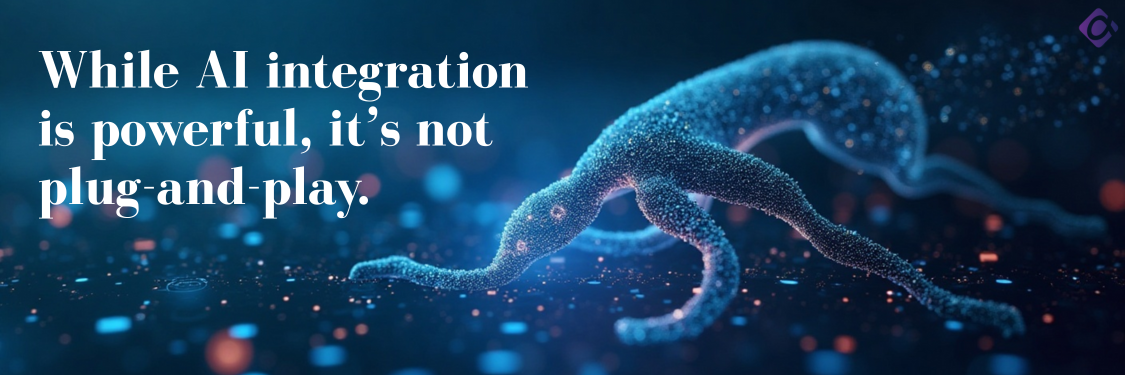The advent of AI system integration signifies a revolutionary step towards smarter, more efficient technological ecosystems. This blog post delves into the multifaceted impact of AI, addressing its benefits and challenges, pivotal technologies, practical applications, and a glimpse into the imminent AI-driven future.
Why AI Systems Integration Matters More Than Ever
According to Gartner, 70% of enterprises will integrate AI into their systems by 2025, up from just 15% in 2021. Why the rush? Legacy systems struggle to keep up with today’s data-driven demands. AI bridges gaps by automating workflows, predicting failures, and adapting in real time. For instance, a project manager drowning in disjointed tools could use AI to unify processes, saving 20+ hours monthly.
Benefits of AI in System Integration
AI-infused systems boast a plethora of enhancements, spanning from superior data handling and predictive analytics to customer experience optimization. These improvements translate into tangible business outcomes, including heightened efficiency and substantial cost reductions.
The incorporation of AI system integration significantly enhances operational capabilities across various dimensions. AI algorithms accelerate data processing and analysis, leading to heightened efficiency in system activities. Predictive analytics empower systems with foresight, enabling preemptive maintenance and informed future planning. AI’s adaptability facilitates customization and personalization, which improves user satisfaction and engagement.
As businesses grow, AI-driven systems skillfully scale to meet increased data demands and evolving objectives without proportionate rises in operational costs. In decision-making, AI contributes valuable insights and data-centric recommendations, bolstering strategic choices. Routine, monotonous tasks are automated by AI, allocating human talent to more intricate and innovative pursuits. Moreover, AI’s precision in tasks like data entry curtails the probability of human error, thereby increasing accuracy. Security, too, is fortified as AI swiftly identifies and mitigates threats, enhancing the security infrastructure of integrated systems.

The Top 3 Benefits of AI-Driven System Integration
Boosted Efficiency & Accuracy
AI eliminates manual tasks like data entry. A McKinsey study found AI-integrated systems reduce human error by 55% while speeding up workflows by 40%.
Cost Savings That Add Up
AI predicts maintenance needs, cutting downtime costs. For example, Siemens slashed energy expenses by 12% using AI-powered IoT platforms like MindSphere.
Scalability Without the Headaches
Cloud-based AI tools let businesses scale without overhauling infrastructure. Retailers like Amazon use AI to manage inventory across 200+ warehouses globally, adapting to demand spikes effortlessly.
Challenges in Implementing AI
Implementing Artificial Intelligence (AI) within system integration presents a series of challenges that organizations must address. The complexity of melding AI with existing infrastructures, particularly older systems not designed for AI, creates compatibility issues. As AI systems heavily depend on data, safeguarding the privacy and security of this data is critical, raising concerns that span legal and ethical domains. The scarcity of professionals proficient in AI technologies can hinder the growth and maintenance of AI-integrated systems, while the substantial initial costs of AI adoption may dissuade some organizations from investing.
AI systems necessitate persistent training and updating to maintain their efficacy, demanding an ongoing commitment of resources. Moreover, the opaque nature of AI decision-making can lead to difficulties in interpretability and transparency, affecting trust and accountability. Lastly, keeping pace with the dynamic regulatory environment surrounding AI poses its own set of compliance challenges. Despite the promise, AI adoption is laden with hurdles, from the complexity of assimilation into legacy systems to addressing data security and the necessity for specialized talent.

While AI integration is powerful, it’s not plug-and-play.
- Data Silos: 47% of firms struggle with fragmented data (McKinsey).
- Ethical Risks: Bias in AI algorithms remains a concern—60% of IT leaders prioritize ethical AI frameworks in 2023.
- Skill Gaps: 54% of companies lack AI expertise, per Deloitte.
Key Technologies and Tools
The integration of Artificial Intelligence (AI) into system architectures necessitates a suite of sophisticated technologies and tools that are integral to AI functionality. Machine learning platforms, such as TensorFlow, Spark MLlib, and Amazon SageMaker, offer comprehensive environments for crafting machine learning models. Natural Language Processing (NLP) technologies like GPT-3 and BERT equip machines with the ability to decipher and act upon human language, enhancing user interactions. Robotic Process Automation (RPA) tools, including UiPath and Blue Prism, streamline rule-based tasks by replicating human actions within digital interfaces. Computer vision is advanced through libraries like OpenCV and APIs such as Microsoft’s Computer Vision, enabling systems to extract intricate understandings from visual content.
Deep learning frameworks like Keras and PyTorch facilitate the development of neural networks capable of pattern recognition and predictive analytics. Cloud AI services from Microsoft Azure, Google Cloud, and IBM Watson democratize access to AI capabilities, broadening their application scope. AI optimization tools, exemplified by Google’s AutoML and H2O.ai, enhance the performance and efficiency of machine learning models. Additionally, data preprocessing and analytics software such as KNIME and Talend are pivotal in refining data for AI usage, ensuring it is clean, structured, and ready for analysis.
The AI toolkit is rich, comprising machine learning algorithms, natural language processing capabilities, and robotic automation. Tools such as TensorFlow and Azure AI are at the forefront, offering robust platforms for AI application development and execution.
Real-World Wins: AI Integration in Action
Healthcare: Saving Lives Faster
Mayo Clinic uses AI to integrate patient records, lab results, and wearable data. This reduced diagnosis time by 30%, directly improving outcomes.
Retail: Personalization at Scale
Amazon Go’s cashless stores rely on AI to sync sensors, cameras, and payment systems, creating a checkout-free experience that boosted sales by 18%.
Manufacturing: Predictive Power
General Electric’s AI-driven Predix platform predicts equipment failures with 92% accuracy, saving millions in unplanned downtime.
The Future of AI System Integration
The horizon of AI’s role in system integration heralds a period of significant advancement and ingenuity. Shortly, we will witness the emergence of highly autonomous systems that self-regulate and make decisions independently, reducing the need for human oversight. Concurrently, the advent of edge computing will propel AI to the network periphery, facilitating instantaneous data processing and responsive decision-making. As the clamor for understandable AI escalates, the industry will pivot towards creating transparent, explainable AI systems. In the realm of workforce dynamics, AI will increasingly be seen as a partner to human intellect, enhancing and working in concert with human skills.
Ethical considerations and governance will gain prominence, steering the course for principled AI development and application. The potential amalgamation of quantum computing with AI promises to revolutionize problem-solving capabilities, vastly surpassing current computational benchmarks. In cybersecurity, AI’s prowess in preempting and neutralizing digital threats will become more nuanced and pivotal. Lastly, AI will serve as a catalyst for cross-disciplinary system integration, dissolving barriers and fostering cohesive inter-industry interoperability. AI’s trajectory is set for further expansion, with anticipation for more self-reliant systems, sophisticated predictive models, and increased democratization of AI technology.

Where Do We Go From Here?
By 2028, the AI systems integration market will hit $126 billion (Statista). Three trends to watch:
- Autonomous Systems: Self-healing networks that fix issues without human input.
- Hyperautomation: Combining AI with RPA to automate complex tasks like contract reviews.
- Ethical AI: Transparent algorithms to build trust. 87% of customers demand this, per PwC.
The integration of AI system integration marks a pivotal transformation in the technological landscape. With AI, systems are not only becoming more interconnected but are also achieving new levels of intelligence and efficiency. The benefits of AI integration are vast, from enhanced operational efficiency and predictive analytics to advanced security measures and personalized experiences. However, these advancements come with their own set of challenges, including system compatibility, data privacy, skilled workforce requirements, and regulatory compliance.
The key technologies and tools that enable AI integration are diverse and powerful, providing the necessary infrastructure for AI applications to thrive. Looking ahead, the future of AI system integration is bright and holds the promise of autonomous systems, edge AI, explainable AI, and a new era of human-AI collaboration. As we navigate this future, it is imperative to address ethical considerations and develop robust governance frameworks to ensure responsible AI development and usage. The transformative power of AI is reshaping system integration, and with careful planning and strategic implementation, it can lead to more agile, responsive, and intelligent systems that propel organizations to new heights of success.
Our team of experts is ready to craft a tailored strategy that leverages the transformative potential of AI, ensuring your systems work in perfect harmony. Contact us now.

